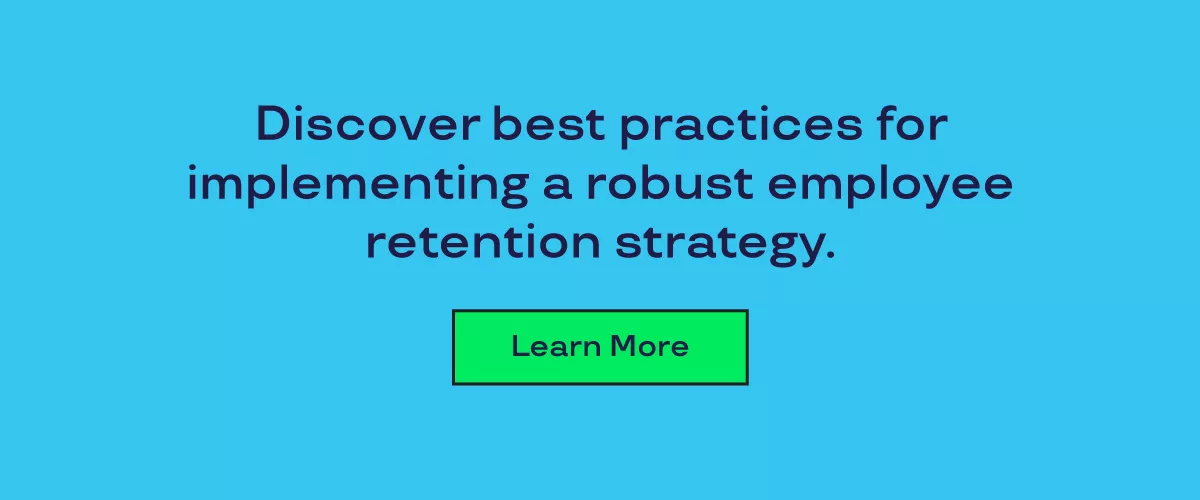
Unlocking Success: The Vital Role of Employee Retention Strategies
December 21, 2023
No company wants to hire an employee only to see them leave at some point in their tenure—especially if they’re a top candidate filling a critical need. Unfortunately, though, employee turnover is an inevitable reality for all businesses.
Employee turnover drives up costs for companies—from recruitment, hiring, onboarding, and training costs to the costs of lost productivity and institutional knowledge. The costs can be significant! Employee retention on the other hand offers a competitive advantage and can help support product and service development and quality, customer satisfaction and engagement, and the overall company brand.
But, retention is a challenge in today’s volatile business environment. According to Gallagher’s 2023 US Organizational Wellbeing Report, “more than half of employers (51%) experienced a turnover rate of at least 15% in 2022, up three points from 48% in 2021.” And Gallup reports that 50% of US employees are open to leaving their current jobs—that’s one out of every two employees. Few, if any, businesses can afford that kind of risk.
The High Cost of Employee Turnover
Employee turnover is costly and directly impacts a company’s success. The direct costs are well known and obvious—for instance, the costs related to finding and hiring new employees. But, as Forbes points out, there are also some hidden costs. These include lost productivity, employee burnout, lost tribal knowledge, wasted time and money hiring replacements, and the costs of training a new employee and risk of making a bad hire.
Turnover can also impact product and service quality and reliability as Wharton professor Ken Moon pointed out in a paper he wrote with colleagues, “The Hidden Cost of Worker Turnover: Attributing Product Reliability to the Turnover of Factory Workers.” Their findings were startling. For instance: “Each percentage-point increase in the weekly turnover rate for workers increased product failure by .75% to .79%.” Costs associated with these and other impacts, they say, “amounted to hundreds of millions of dollars.
In addition, employee turnover can also impact morale and the company culture.
The Impact of Employee Retention Strategies on Business Success
Employee retention can have the exact opposite impact on employee turnover. Employee retention directly impacts productivity, reduces recruitment costs, and contributes to an engaged workforce. High retention rates signal that employees are satisfied, engaged, and committed to their jobs and to the organization.
The more stable an organization, the more comfortable employees are working and collaborating with each other. Trust is established and organizational knowledge is strengthened.
Certain companies are well known for their ability to attract and retain talent. For instance, CNBC reports that DuPont is the company with the best employee retention according to research by Workforce Logiq. Only “20”% of DuPont workers are likely to engage with a recruiter message offering a new job opportunity,” they say. That’s in stark contrast to Gallup’s 50% statistic!
Other top companies that showed up in the research include Honeywell, Lockheed Martin, Delta, Merck, Amazon, Microsoft, Intel, Best Buy, American Express, Cisco and Coca-Cola. These companies offer benefits that employees value like career development and advancement opportunities, strong leadership, and a positive culture and environment.
These factors are some of the key components of effective retention strategies.
Key Components of Employee Retention Strategies
There are no one-size-fits-all solutions or silver bullets when it comes to establishing an environment that will contribute to employee retention. But, there are some common elements that can work together to create that environment: competitive compensation, career development opportunities, respect for work-life balance, a positive work environment, and ongoing feedback and communication.
- Competitive compensation isn’t just about money—it also includes the overall benefit package and things like paid leave, wellness programs, flexible working schedules, etc.
- Career development tops the list for many employees these days, often listed as the most important factor keeping them at their jobs, according to LinkedIn research.
- Experiences during the pandemic have made work-life balance increasingly important for employees. Having that balance can lead to better job satisfaction, engagement, and retention.
- A positive work environment that values diversity and supports inclusion and belonging is a key factor in building productive relationships and strengthening retention. Managers, of course, play a key role in supporting a positive environment.
- Feedback and communication are vital—not only for engaging employees, but also for ensuring that they understand how their work impacts the organization and ways they can continue to improve the positive impact they make.
By focusing on these key components, organizations can create an environment that is supportive and that leads to engagement—and retention.
Employee Retention Best Practices
There are a number of best practices that organizations can consider to help boost employee retention that are aligned with and supportive of the key components of effective retention strategies. For instance:
- Mentorship programs. Mentorship programs can help employees build both relationships and new skills and competencies.
- Ongoing training. As we’ve seen, career development is a top priority for today’s employees. Ongoing training opportunities can help employees build skills to meet their personal and professional goals.
- Recognition initiatives. Recognition serves to acknowledge and reward employees for their hard work and achievements. Recognition works. Companies that offer effective employee recognition have employees who are 56% less likely to be looking for new opportunities elsewhere.
Assessing your current practices can help you identify areas of strength as well as areas of opportunity for improvement.
Measuring the Effectiveness of Retention Strategies
If you aren’t measuring the effectiveness of your retention strategies, you can’t possibly take steps to improve! It’s important to track and monitor retention efforts to identify strategies that work well—and those that don’t. Each organization will be different. Having data that is specific to your organization and its efforts can support continuous and positive improvement.
Some metrics that can yield important insights into retention strategy effectiveness include turnover rates, employee satisfaction surveys, and productivity. Monitoring these metrics over time can identify trends and offer early warning signs that may require course correction or changes in strategy.
Building a Customized Retention Plan
It’s important for each organization to develop a customized retention plan tailored to their organization’s unique needs—and the needs of their employees.
The following steps can help put your company on the path to improving retention and boosting engagement, satisfaction, and productivity:
- Analyze existing turnover and retention rates.
- Identify problem areas.
- Develop tailored retention strategies.
- Implement feedback and communication channels.
- Monitor and evaluate the effectiveness of your retention plan over time.
These and other strategies can help you build a foundation to support employee retention. All organizations will be different. All employees will also be different. Plans need to be customized as well as flexible and adaptable to accommodate changes that may be identified through data and analysis.
To ensure the long-term success of your organization, it’s essential to invest in employee retention efforts. By focusing on key components such as competitive compensation, career development opportunities, work-life balance, a positive work environment, and ongoing feedback and communication, you can create a supportive environment that fosters engagement and retention. Implementing best practices like mentorship programs, ongoing training, and recognition initiatives can further enhance your organization's retention strategies.
Investing in employee retention isn’t just a smart business decision—it’s key to your company’s longevity and sustainability. Take steps to create an environment that attracts and retains top talent long term.
Inspirus offers employee engagement solutions that can support and improve employee retention—like Inspirus Connects to help employees connect with and recognize each other, and tools to collect feedback to monitor employee sentiment and identify potential retention risks.
Learn more about the steps you can take to boost employee engagement and retention—especially during an economic downturn.





